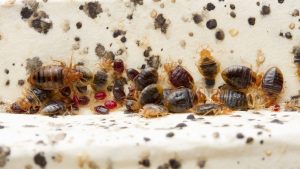
Histamines produced by bed bugs can persist for some time after bed bugs have been eliminated. (Photo: Matt Bertone)
A new study from North Carolina State University shows that histamine levels are substantially higher in homes infested by bed bugs than in uninfested homes. The study also found that these histamine levels persist for months – even if the bed bugs have been eliminated from the home. These findings suggest that bed bugs may be more than just a mere nuisance pest. The bed bug-produced histamines could pose a serious health risk in the indoor environment.
NC State post-doctoral researcher Zachary DeVries and colleagues from NC State and the N.C. Dept. of Health and Human Services conducted a Raleigh-based study to compare histamine levels in homes with and without bed bug infestation. The researchers also evaluated the persistence of histamine following bed bug eradication.
“Histamine levels in bed bug infested homes were at least 20 times higher than histamine levels in homes without bed bugs,” DeVries said. “And these levels didn’t decrease much three months after treating the infested homes with heat and insecticides.”
Histamine was recently identified as a close-range aggregation pheromone component in bed bug feces. Exposure to histamines in the environment can provoke allergic responses and asthma. High concentrations of histamine can readily become airborne and represent the major route of entry of allergens into the airway, as documented in studies correlating cockroach allergens in settled and airborne dust. The potential health risks associated with bed bug-produced histamine might rival those associated with other indoor pests, namely cockroaches and dust mites.
Using a Raleigh apartment complex as a study site, the researchers collected the household dust in apartments with bed bugs and those without. Those apartments with bed bug infestations had substantially higher histamine levels in dust than apartments with no evidence of bed bugs as well as “control” apartments some miles away that had no history of bed bug infestation.
The researchers also tracked histamine levels over time after having infested apartments professional heat treated. Histamine levels did not decline significantly three months after treatment, showing the chemical’s capacity to persist despite extreme heat.
“A combination of heat treatment to eradicate bed bugs and rigorous cleaning to eliminate some of the household dust could be a way to reduce these histamine levels; we’ll do future testing to bear that out,” DeVries said. “We’ll also further investigate the effects of histamine in an indoor environment, including chronic exposure to histamine at low levels.”
The research appears in PLOS ONE. Coby Schal, Blanton J. Whitmire Professor of Entomology at NC State, co-authored the paper along with research specialist Richard Santangelo. Alexis Barbarin of the N.C. Dept. of Health and Human Services also co-authored the paper.
Funding for the work came from the U.S. Department of Housing and Urban Development, the Alfred P. Sloan Foundation, the National Institute of Environmental Health Sciences, and NC State’s Blanton J. Whitmire endowment.

